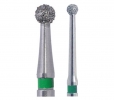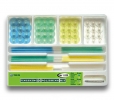This in situ study investigated the secondary caries development in dentin in gaps next to composite and amalgam.
For 21 days, 14 volunteers wore a modified occlusal splint containing human dentin samples with an average gap of 215 µm (SD = 55 µm) restored with three different materials: Filtek Supreme composite, Clearfil AP-X composite and Tytin amalgam.
Eight times a day, the splint with samples was dipped in a 20% sucrose solution for 10 min. Before and after caries development, specimens were imaged with transversal wavelength independent microradiography, and lesion depth (LD) and mineral loss (ML) were calculated.
The LD and ML of the three restoration materials were compared within patients using paired t tests (α = 5%). In total 38 composite samples (Filtek n = 19 and AP-X n = 19) and 19 amalgam samples could be used for data analysis.
AP-X composite presented the highest mean values of LD and ML of the three restorative materials. Amalgam showed statistically significantly less ML (x0394; = 452 µm × vol%) than the combined composite materials (p = 0.036). When comparing amalgam to the separate composite materials, only AP-X composite showed higher ML (x0394; = 515 µm × vol%) than amalgam (p = 0.034). Analysis of LD showed the same trends, but these were not statistically significant.
In conclusion, amalgam showed reduced secondary caries progression in dentin in gaps compared to composite materials tested in this in situ model.
Source: PMID: 26407050 [PubMed - in process]
Publication date: 2015 Sep 26




